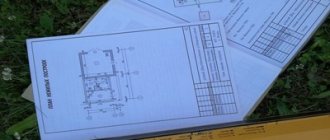Home / Real estate / Land / Ownership / Registration
Back
Published: 07/09/2017
Reading time: 7 min
1
778
Quite often situations arise where there are no documents for the land, but also for its legal owner. Therefore, the actual user expresses a desire to become its legal owner, but what if there are no supporting documents? Is it possible to register the land in this case?
You will find answers to these and related questions in this article.
- Types of land documents
- Without what documents can you register land?
- How to register a plot of land without documents: step-by-step instructions
The house and land are registered to the same owner
According to this legislation, a residential building and the plot on which it is located are one piece of real estate. They form a single whole, which means it won’t be possible to sell one without the other. This situation is discussed in Article 35 of the Land Code.
Moreover, it is impossible not only to sell, but also to inherit one without the other.
And even the amendments made to this article on June 23 did not change the situation. The house and the plot are one object. This means that if the owner tries to sell only the house, he automatically sells the land along with it.
If the purchase agreement stipulates the sale of only one house without adjacent land, then it is considered an invalid agreement. In some cases, execution of such a transaction may be considered fraud.
Nuances during recovery
Until 1998, documents related to real estate transactions were registered with the BTI or the local administration. The registration of land plots was carried out by the land committee. There was no uniform procedure, so it is possible that the applicant will be referred from one authority to another.
Important! Let's take a closer look at where to go if you don't have any title document:
- There is no certificate of ownership of the property. In this case, you should submit an application to the Office of the Federal State Registration Service;
- The applicant does not have supporting documents. It is necessary to contact the archive to obtain copies of the original documents;
- The certificate for a house built before 1993 has been lost. An application for restoration of the certificate is drawn up and sent to the Registration Chamber;
- There is no certificate in the new form. Contact the Rosreestr branch at the place of real estate registration. The certificate will be issued based on the cadastral number.
If, when purchasing property, the purchase and sale (donation) agreement is notarized, then a copy of the document can be requested from the notary. If the transaction was carried out more than 10 years ago, you must contact the archives of the notary chamber. Such a document is required primarily when determining land ownership.
What documents are needed to buy a summer house?
How to register at your dacha, read here.
How to combine land plots into one, read the link:
The house is registered to one owner, and the plot to another
But there are cases when the building and the site belong to different owners.
This is possible when a citizen owns the house directly, and disposes of the land on the basis of a lease. In this case, according to Part 3 of Article 552 of the Civil Code of the Russian Federation, along with the house, the buyer automatically acquires lease rights to the land, provided that the lease agreement is not currently expired.
But the new owner will not have ownership rights to the land since they remain with the tenant of the land. He only owns the house. All rights to the land will be specified in the lease agreement. He must continually renew this agreement while maintaining the original terms.
It is also possible that the seller does not own the land, but it is registered in his name on the basis of an agreement for unlimited use. Only in this case, only one house standing on the ground is sold.
If documents are lost
In cases where the applicant, for various reasons, is unable to provide documents, they contact Rosreestr or the local administration to request duplicates. But in this case it is necessary to follow the procedure.
First, you should contact your local newspaper with a statement about the loss of documents and their invalidation. The application indicates the address and cadastral number of the property, the number of the title document and the date of issue.
The advertisement must be attached to the application for a duplicate. A copy of your passport will also be required to apply.
The application must set out the circumstances under which the title documents were lost. After receiving the application, permission to issue a duplicate is issued. This document is attached when submitting a set of documents to identify the owner of the property.
After checking the documents at the settlement administration, they are sent to Rosreestr for verification. The applicant is informed of the date when the duplicate title certificate will be ready.
ATTENTION! Look at the completed sample application for a copy of an archival document confirming the right to land ownership:
Attention! Our qualified lawyers will assist you free of charge and around the clock on any issues. Find out more here.
How to buy or sell?
Another option is to purchase a house, but not with all the land, but only with part of this plot. This is quite possible. But this requires the entire plot to be divided into shares that will be sold. This is done through demarcation. Each of the new parts will have to receive its own cadastral passport and number, as well as an address. In this case, only the plot on which the house is actually located can be sold.
But this is only possible if the smallest dimensions of the land are met. They may vary depending on the region of the country.
There are also situations where the land under the house is not formalized at all. For example, if it is government-owned and belongs to a specific department. In the future, it will be possible to contact this department and rent a plot under the house or only part of it. And if possible, then buy it back.
But even with this development of events, the owner of the house still has the right to use the land, at least to the extent necessary to maintain the building he owns.
Simplified registration
If a person received a plot before October 30, 2001 (before the Land Code came into force) for personal farming, for construction or a dacha, then he has the right to become an owner in a simplified form - under a dacha amnesty. To do this you must submit:
- identification;
- technical plan;
- document on the provision of land (act, decision).
Example . In 1983, Stepan Petrovich, based on a resolution of the local Council of Deputies, was allocated a plot of land for a dacha. Having documents in hand, he applied to Rosreestr to become the legal owner of the house. As a result, he received an extract from the register of rights to real estate.
Photo: John Lambeth/pexels.com
Attention! In this way, an object on land allocated for individual construction or located on the territory of a settlement and intended for subsidiary farming can be registered until March 1, 2021 (Article 5 of Federal Law No. 267 of 08/02/2019).
Screenshot of the application form for state cadastral registration of real estate in Rosreestr
Donation agreement
As for the donation procedure, the situation is exactly the same. It is impossible to donate a house without adjacent land. From the point of view of the law, these are the same property. But even here it is allowed to divide the land into parts and donate one of the parts (as described above). You can divide a plot by assigning each of the new plots its own cadastral passport and address. Naturally, minimum dimensions must be observed. The rest of the procedure follows the standard scheme using a regular gift agreement. In this case, you can only donate one of the new real estate objects. For example, part of a new plot, or a house with the remaining land.
How to register a house without documents
Before you start registering ownership of a house or plot in the village, you should find any documents confirming ownership. To do this, you need to request documents from the archive.
As a rule, documents containing information about the owners of the property are stored in the archives at the location of the house. If there is confirmation of the validity of registering the house as a property, the procedure for registering property will be significantly simplified.
Please note! In addition to the certificate received in the archive, it is necessary to prepare the following documents:
- A copy of the cadastral passport;
- Site plan indicating located buildings;
- Passport of the person registering ownership of the property;
- Application for registration of real estate;
- Receipt for payment of state duty.
It would not be superfluous to provide testimony from neighbors confirming that the applicant has been living in this territory for a long time on a permanent basis. The above documents are provided to the administration of this settlement.
By will or without a will?
The simplest option is to receive an inheritance under a will. In this case, only those indicated in the will, as well as legal heirs, can claim ownership of the property .
In this case, the share of heirs by right can be determined only in court and only after filing an application to enter into inheritance by right.
The absence of a will automatically “activates” the queue of heirs , at the stages of which, as the relationship with the deceased grows remote, relatives of different categories “line up”.
Heirs in such a situation must notarize their rights to receive the inheritance with the provision of documents showing the degree of relationship.
About taxes
After entering into an inheritance, the recipient will need to pay a tax (state duty), determined in accordance with the value of the property received as an inheritance.
It will need to be paid before the end of the current reporting period at the time of inheritance.
Exempt from tax:
- heroes of the USSR and the Russian Federation;
- holders of the Order of Glory 3 degrees;
- persons recognized as disabled people of groups 1 and 2;
- disabled children;
- participants in the Civil War, World War II or other military operations;
- military personnel.
For all other categories, the tax amount is determined from the standard 13% due to be transferred to the tax authorities on any profit received.
Features of land plot design
When registering ownership of a land plot, there are some nuances. First, you will need information about the owner of the site.
It is possible that the land plot is owned by the municipality. In this case, the site must be privatized.
Privatization involves a set of measures:
- Land surveying and establishing boundaries;
- Preparation of an application for privatization to a municipal entity ();
- Approval of the privatization of a plot with the specified boundaries;
- State registration of ownership of this land plot ().
ATTENTION! Look at the completed sample application for land surveying:
What cannot be legitimized:
- If the extension crosses the “red lines” of communications (for example, a gas pipeline);
- If part of the forest fund land is captured;
- If part of the neighboring land plot is cut off.
It is possible to legalize cut-off plots of land that no one claims and they must be in state or municipal ownership.
Notice! When starting the privatization procedure, you should remember that privatization documents will be reviewed within 30 calendar days from the date of their submission. Registration of ownership is carried out within 7 days.
If the site is owned by an individual or legal entity, then privatization will not be required. If there are buildings on the site, they should be registered as property along with the site.
Watch the video. How to register land ownership?
Registration by acquisitive prescription
As practice shows, it is possible to register ownership of a house or plot in a village thanks to acquisitive prescription. This method should be used if it is established that the plot (or part of the plot) has been in the use of a citizen for more than 15 years. Moreover, the acquisition limitation period is counted from the moment of acquisition from third parties, even if the property is disposed of by a legal successor.
Such property is registered as ownership if it is established that the citizen has used the property continuously and conscientiously, as if it were his own. This fact is confirmed based on the testimony of neighbors.
Where to go to inherit an inheritance?
How to register an inheritance for a house correctly? To enter into an inheritance, a potential heir will need to submit a package of supporting documents to a notary at the location of the inherited property.
An important condition is the provision of documents before the expiration of 6 months after the death of the testator .
You will need to look for a notary office at the place of official registration of the testator at the time of death.
The basis for opening an inheritance is a death certificate , and the date is always the date of death.
How to legalize an old non-residential property for which there are no documents?
Many managers of enterprises created on the basis of old Soviet organizations are aware of the problem of illegal ancient buildings. Well, for example, there is a certain ancient warehouse or granary on your territory, and you don’t have a single piece of paper for it. That is, you do not have the opportunity to register property rights in the prescribed manner. This situation is especially common among former collective farms, which at one time did not have any difficulty in obtaining construction permits or putting facilities into operation.
For a very long time, such objects were actually equated to unauthorized buildings and were legalized on the basis of Art. 222 of the Civil Code of the Russian Federation. Then the legislation and judicial practice on the recognition of rights to “AWOLs” became much stricter, and many buildings were left without owners (and the owners - without buildings). However, at the end of 2012, a very interesting Resolution of the Presidium of the Supreme Arbitration Court dated September 25, 2012 No. 5698/12 in case No. A41-9398/11 was published on the website of the Supreme Arbitration Court. With this decision, the Supreme Court actually opened the way for the legalization of such objects, launching a kind of “amnesty” for non-residential buildings. This article is actually an interpretation of this resolution and may not entirely correspond to the secret thoughts of the high judges, but nothing can be done about it: someone else’s soul is in the dark. So, what does YOU write to us? In the case analyzed by the supervisory authority, the following situation was considered: an agricultural organization (Agrotechservice LLC), which is the legal successor of an agricultural partnership, filed a claim with the arbitration court to recognize the ownership of real estate as unauthorized buildings, on the basis of Article 222 of the Civil Code of the Russian Federation . These buildings were erected by the plaintiff's predecessor (an agricultural partnership) in 1993 on a plot of land allocated to this partnership in 1991 for the construction of an industrial base. At the same time, the buildings were erected on an economic basis at the expense of the partnership’s own funds, a construction permit was not issued, and the facilities were not put into operation. In 1994, the land under these objects was provided for permanent (indefinite) use to the plaintiff. Subsequently, the plaintiff repeatedly tried to put the already constructed facilities into operation administratively, but was unable to do so due to the lack of a construction permit. The first two instances satisfied the claim, but the district court overturned their judicial acts and terminated the proceedings due to the fact that the Society had previously tried to recognize the ownership of these buildings, but was refused due to the fact that at the time of consideration of the previous claim no administrative commissioning procedure was used. However, the Presidium of the Supreme Arbitration Court reviewed the decision and satisfied the claim, justifying its position as follows. 1. The court indicated that “buildings, structures and structures for non-residential purposes, constructed before 01/01/1995, by virtue of the law cannot be recognized as unauthorized constructions... Therefore, the claim of the Agrotechservice company for recognition of the ownership of the real estate objects created by it as unauthorized constructions ... was not an appropriate method of protection.” At the same time, the Supreme Arbitration Court pointed out that the court could have qualified the relationship independently, i.e., the choice of the wrong method of protecting the right in this situation should not have served as a reason for refusing the claim, since the requirements were formulated correctly. 2. In addition, the court indicated that for objects built before the 2004 Urban Planning Code of the Russian Federation came into force, state registration of rights must require the provision of those documents (permits) that were necessary at the time of the creation of these objects. For non-residential properties built before 01/01/1995, the regulations governing construction and the emergence of ownership rights were:
- Law of the RSFSR dated December 24, 1990 N 443-1 “On Property in the RSFSR,” which establishes that a citizen or organization receives ownership of property acquired by them on grounds that do not contradict the law, in particular as a result of new construction. Please note that this standard also applies to facilities built before 1990. That is, if an object was built before 1990 (before the concept of private ownership of real estate appeared) legally, then from 1990 the right to it still arises.
- Resolution of the Council of People's Commissars of the RSFSR dated May 22, 1940 N 390 “On measures to combat unauthorized construction in cities, workers, resort and holiday villages,” which established that construction permits are issued by city and village executive committees. At the same time, the Supreme Arbitration Court indicated that if, after completion of construction, the administration of the city (village) somehow expressed its consent to the location of the controversial facility, for example, by providing land for its operation, then this means authorization of the previously completed construction.
- The procedure established by Resolution of the Council of Ministers of the USSR dated January 23, 1981 N 105 “On the acceptance into operation of completed construction facilities.” However, the court noted that this procedure applied to those production facilities that were built using centralized capital investments allocated to ministries and departments. that is, for objects built on an economic basis, documents for commissioning should not have been issued.
So, what is needed to legitimize non-residential properties built on an economic basis before 01/01/1995. The court did not answer this question clearly and fully, but from the analysis of the ruling I would like to draw a number of conclusions:
- Firstly, land allotment documents are needed, since at all times it was possible to build only on the land that was allocated to the developer, otherwise it is not possible to talk about the legality of the structure. It is advisable that at the time of construction there is already a land allotment. Let us note that the Presidium does not directly write on the issue of the mandatory provision of land allotment documents to the court, but in the case considered, land was provided. If we analyze the judicial practice that has already arisen on the basis of this Resolution of the Presidium, then in all cases of satisfaction of the claim, the issue of land is also considered (Resolution of the Federal Antimonopoly Service of the Ural District dated 01.02.2013 N F09-13491/12 in case No. A76-5924/2012; Resolution FAS East Siberian District dated 04/08/2013 in case No. A19-16039/2012; Resolution 18AAS No. 18AP-9128/2013 dated 09/16/2013 in case No. A07-20863/2012). Let us note that in cases of recognition of rights to real estate by acquisitive prescription on the basis of Art. 234 of the Civil Code of the Russian Federation, the courts are more loyal to the land allotment issue and do not always focus on this, however, in the Chelyabinsk region there are very few positive decisions on this article (refusals are motivated by other reasons, which we may also write about in the near future).
- Secondly, documents on construction using an economic method before 01/01/1995 are required. Such documents, I think, may well be your own (on-farm) acts of commissioning or orders for commissioning, accounting cards for accounting for fixed assets, invoices for receiving construction materials, payment orders or contract agreements (if preserved), project documentation (at least partially, if developed). In each case, I think you should rummage through the bins and approach the issue creatively. The main thing is that an acceptance certificate by the State Commission is not required.
- Thirdly, a building permit (if available). If it is not there, then it can be replaced by any document confirming the consent of the authorized body to locate this object. It can be assumed that the document on the allocation of a land plot itself replaces a construction permit, since the permit is usually issued and the land is allocated by the same body, but this is not directly stated in the resolution of the Presidium. Let us note that in the resolution of the Federal Antimonopoly Service of the East Siberian District dated 04/08/2013 in case No. A19-16039/2012, adopted on the basis of the decision of the Presidium under consideration, a construction permit is indicated as a mandatory document, although this position does not correspond to the position of the Supreme Court)
Resolution of the Federal Antimonopoly Service of the East Siberian District dated 04/08/2013 in case No. A19-16039/2012 (excerpt): “Thus, based on the stated claims, taking into account the interpretation of the above-mentioned rules of law ... as well as clarifications of the Supreme Arbitration Court of the Russian Federation, the plaintiff within the framework consideration of this case ... must confirm that he has the right to bring such a claim, ... prove the legality of the grounds for the plaintiff's right of ownership of real estate (provide evidence confirming the right to construction and the fact of creating a new property: evidence of the provision of a land plot to the cooperative for the construction of a vegetable storehouse in the procedure established by law, the issuance of a permit for the construction of an object provided for by current legislation, the construction of an object by a cooperative using the funds of its members).”
- Fourthly, if you did not build the object yourself, but the legal predecessor of your organization, then you must provide documents on legal succession.
- Fifthly, the Presidium hinted at the provision of documents relating to the safety of the constructed objects: “Documents allowing the court to conclude that the created real estate objects do not threaten the public interests, life and health of people by the Agrotechservice society have been received from the competent authorities and presented by the courts lower authorities have been investigated." Typically, such documents are provided when considering cases specifically on the recognition of rights to “AWOL”, so the approach of YOU is surprising. However, the Supreme Court apparently decided to play it safe, since security is still an important matter. True, in other decisions written on the basis of the Resolution of the Presidium, this point is not mentioned at all.
The procedure for legitimizing old non-residential buildings, as a conclusion from the Resolution of the Presidium. Choosing a method of protecting rights. Administrative procedure . In general, the position of the Presidium regarding such buildings is that the right of ownership to them arises not due to its recognition by the court, but due to the legality of the construction on the basis of the RSFSR Law of December 24, 1990 N 443-1 “On Property in the RSFSR”. Thus, the right is previously arisen, i.e. in accordance with Art. 6 of the Federal Law of July 21, 1997 N 122-FZ “On state registration of rights to real estate...” must be registered by Rosreestr without a court decision recognizing ownership rights. The judicial procedure is like appealing the refusal of Rosreestr. In case of refusal of registration, such refusal can be appealed in accordance with Chapter 24 of the Arbitration Procedure Code of the Russian Federation. Claim procedure - filing a claim for recognition of ownership rights However, the resolution of the Presidium itself considers the situation when it is the claim for recognition of ownership rights that is satisfied, and not the application to challenge the actions of Rosreestr. The Presidium explains this circumstance by the fact that precisely in the case under consideration, due to the plaintiff having a negative decision in the previous case, he is deprived of the opportunity to apply to the registration authority to register ownership, since the building has already been recognized by the court as unauthorized. In other situations, compliance with the pre-trial registration procedure is, perhaps, mandatory. This opinion is set forth by the Resolution of the Federal Antimonopoly Service of the Moscow District dated February 13, 2013 in case No. A41-16281/12. There is, however, in practice another understanding of the explanations of YOU. In particular, the Federal Antimonopoly Service of the Ural District, in a resolution dated 02/01/2013 N F09-13491/12 in case N A76-5924/2012, in a similar situation still recognized the ownership of the building, ignoring the instructions of the Supreme Arbitration Court that the method of restoring the right should be administrative. In the same resolution, the FAS Ural Federal District indicated that it is unacceptable to apply the rules on acquisitive prescription in such circumstances.
In general, we can state that there are still a lot of questions, however, if you have land and at least some old construction documents, it is certainly worth trying to legalize the construction. After the Presidium's resolution is issued, this should happen.
The material was prepared by Tatyana Novokreshchenova and Tatyana Skvortsova.
About our legal services for the legalization of real estate, see HERE







